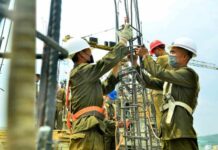
Kim Jong Un recently admitted that his country’s regional economy is in a “pitiful state.” He confessed that “our party and state are facing a serious political problem that we cannot smoothly provide even the basic daily necessities for our people.”
The “20×10 regional development policy” presented by Kim Jong Un at the 19th Enlarged Meeting of the Political Bureau of the Eighth Central Committee of the Workers’ Party of Korea is a farce. Although the policy aims to promote people’s livelihood and regional development, it only reveals the dismal reality of the North Korean economy, which fails to provide even a reliable supply of red pepper paste to the country’s people. The policy aims to push forward with the construction of factories in 20 cities and counties within a decade. The government intends to reduce the disparities between Pyongyang and the regional provinces and improve people’s livelihoods. The North Korean regime has produced ideological propaganda to carry out this policy. It has escalated the propaganda frenzy by creating nine related propaganda images with titles such as “Our party’s long-awaited dream, the grandiose revolution.”
North Korea’s regional economic problems are dire. At the 19th Expanded Meeting, Kim Jong Un described the countryside as “an era-defining symbol of backwardness.” In my view, the 20×10 regional development policy is doomed to failure. The policy proposal itself is contradictory. It will be 2034 in a decade. The world is currently reorganizing itself around an AI-driven global industrial structure. In an era when high-tech industry determines a country’s destiny, Kim Jong Un has proposed building a few factories in the regional countryside to provide necessities. His proposal is outdated.
The regime has widely used the success story of Kimhwa County in its propaganda. Ironically, the success story only exposes the flaws in Kim Jong Un’s policies. The Korean Central News Agency constantly broadcasts a video on Kimhwa County praising how the county has successfully created products by using specialties of the region. The video claims that the county has used thorn bushes to produce jam and sugary drinks and corn and beans to produce staple foods. The video emphasized the county’s innovation in using oil extracted from tetradium to make soap and oil extracted from burl to make products. Similarly, the propaganda art promoting the 20×10 regional development policy has slogans such as “Let’s make effective use of the economic resources and raw materials of cities and counties.”
Similar claims can also be found in Rodong Sinmun news articles. An article published on Feb. 3 stated that “the people’s livelihood will be greatly improved if counties near mountains use mountain resources and those near the sea use sea resources to produce distinctive light industry products, furniture, and daily necessities. In short, the essence of Kim Jong-un’s policy proposal is to use raw materials extracted from local mountains and seas to produce necessities.
In the era of the Fourth Industrial Revolution, South Korea is achieving revolutionary economic progress by forming regional industrial clusters focused on semiconductors, IT, AI, and robotics. North Korea may call what it is doing a “local revolution,” but it amounts to little more than producing food products such as soybean paste and red pepper paste from the fruits available in the mountains. The North Korean regime plans to do this for the next 10 years. Does it make sense to focus a country’s food supply strategy on harvesting fruits and seaweed in 2034?
Another reason why the regional development policy is bound to fail is that it mobilizes the Korean People’s Army (KPA) to build factories. It’s easy to see that the KPA has been mobilized for this purpose from propaganda slogans such as “In the struggle for the development of the provinces, let the KPA be the horseman and protagonist.” Meanwhile, Kim Jong Un is raising tensions on the peninsula by announcing that a war will begin this year. However, while Kim Jong Un claims to be preparing for war, the KPA has only been mobilized to build factories.
Kim Jong Un has been talking about war and “two separate states” since the beginning of the new year because North Korea is facing internal economic hardship and external geopolitical instability. Unable to meet his people’s basic needs for food, water, and heat, he has pointed the finger at external enemies. North Korea’s future appears bleak as it continues to use tree nuts to fuel its factories in a global era characterized by drastic daily changes. We can no longer stand idly by. We cannot allow the cries of agony and despair of the North Korean people to continue until 2034.
The translator requested anonymity. Edited by Robert Lauler.
Views expressed in this guest column do not necessarily reflect those of Daily NK. Please send any comments or questions about this article to dailynkenglish@uni-media.net.

















